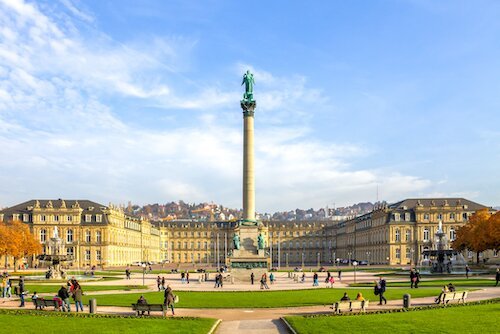Hauptbahnhof

Many journeys begin or end at the Hauptbahnhof. It is Stuttgart’s primary train station, and travelers can take a trip to most major destinations in Germany from the Hauptbahnhof.
Opened in 1922 and designed by architect Paul Bonatz, the Hauptbahnhof withstood the bombs of World War II and is one of the most prominent historical landmarks in the city. In recent years, plans to demolish some parts of the station to modernize it have been met with fierce local opposition.
Perhaps, the most iconic part of the Hauptbahnhof is the rotating illuminated Mercedes-Benz sign that sits atop a 12-story tower located at the station.
Stadtbibliothek Stuttgart

The city library, Stadtbibliothek, is 11 minutes away from Hauptbahnhof. It's rather unusual to recommend a library as a place to visit while you're on vacation. However, there's a good reason for this.
Designed by South Korean architect Eun Young Yi with inspiration from the ancient Pantheon, the building housing the library is fascinating in many ways. Its contemporary exterior has a simple but elegant look that makes you want to stare. The pristine white interior illuminated by the central roof light gives it a pure and serene ambiance.
Once you're done ogling the orderly shelf arrangements, stop by Café Lesbar at the top for refreshments. Feel free to ignore the books. You're here to take in the beauty of the building. However, if you feel guilty about not reading a book in the library, pick one up and enjoy it in one of the reading rooms.
If you think a library building couldn’t possibly look any better, stop by at night to enjoy the view as the panels light up to reveal an even more beautiful side of the building's modern architecture.
Schlossplatz

Schlossplatz is Stuttgart’s famous palace square. It is a popular destination for locals and tourists throughout the year thanks to its vast expanse of well-manicured lawns, and the city’s famous Christmas markets that open in November.
The Schlossplatz is the beating heart of the city. It is centrally located near Stuttgart’s other popular tourist attractions so tourists can conveniently explore landmarks on foot.
Visitors can experience regular events at the Schlossplatz including festivals and concerts. The square is right next to the Wurttemberg State Museum, which is housed in the former Old Palace of the Wurttemberg region. The museum was founded in 1862 and is filled with an assortment of carefully categorized treasures and masterpieces from German history.
Fernsehturm

The Fernsehturm tower stands 710-feet tall and looks over Stuttgart like a proud protector. Fernsehturm was the world’s first television tower as it beamed signals to antennas all over the southwest region of Germany.
The tower began operating in 1956 and quickly became the prototype for similar towers in other cities around the world. Today, the Fernsehturm is arguably Stuttgart's No. 1 landmark.
Tourists can ascend the tower to dine at the Panorama Cafe or the Restaurant Leonhardts. There is also an observation deck at the top of the tower that provides beautiful views of Germany’s sixth largest city.
Ludwigsburg Palace

About 40 minutes away from the city center, Ludwigsburg Palace is a sprawling 18th-century Baroque palace with grounds that rival the best of French chateaus. Commissioned by then Duke of Württemberg, Eberhard Louis as a ducal residence, construction commenced in 1704 but wasn't completed until 1733.
It is one of the largest Baroque palaces in Europe and is nicknamed the Versailles of Swabia. The palace has four wings and includes 18 buildings with a mind-blowing 452 rooms.
Walking through the rooms of the palace takes visitors through Baroque, Rococo, and Neocalssical features, thanks to the different renovations that occurred after the death of Eberhard Louis.
The palace now houses several museums, including a fashion museum that stages shows with clothing from the 18th to the 20th centuries. Other museums include the Ceramic Museum showcasing contemporary ceramic art, the Kinderreich Children’s Museum, and the Baroque Gallery.
The grounds around the palace have lawns and gardens with geometric patterns that rival those seen in Château de Chantilly in France and can be best appreciated via aerial views.
Cannstatter Volksfest
The Cannstatter Volksfest is one of the world’s largest festivals. The festival has been running for over 200 years, and it is a staple of the Stuttgart area. It takes place in late September and runs until the middle of October attracting visitors from all over the world.
So, what is the annual Cannstatter Volksfest? It is a beer festival and traveling funfair. Most tourists know the event as the Stuttgart Beer Festival. One of the most significant events of the entire festival is the annual tapping of the keg which takes place during the opening ceremonies.
Visitors to the Cannstatter Volksfest will find plenty of rides, food and drink, and a large parade during its opening weekend. The festival is a family affair and has been for over two centuries.
Porsche Museum

Opened in 2009, the Porsche Museum is a stunning piece of architecture, with its sleek design echoing Porsche's innovative spirit. Inside, visitors can explore over 80 vehicles on display, ranging from early prototypes and race cars to the latest Porsche models. The museum showcases the brand's evolution, offering a deep dive into its engineering, design, and racing heritage.
In addition to the impressive collection of cars, the Porsche Museum provides interactive exhibits and multimedia displays that bring the brand's history to life. Visitors can learn about the company's founder, Ferdinand Porsche, his work in automotive design, and the brand's success in motorsports.
The museum regularly hosts special exhibitions and events, making it a great destination for Porsche fans and casual visitors. The museum offers a perfect opportunity to experience the legacy of this legendary automaker.
Mercedes-Benz Museum

The Mercedes-Benz Museum in Stuttgart is a world-class attraction that takes visitors on a journey through the history of one of the most prestigious automobile brands. Located near the company’s headquarters, the museum showcases over 130 years of innovation and excellence in automotive engineering.
The building is an architectural marvel, designed in a spiral shape that mirrors the timeline of Mercedes-Benz’s remarkable legacy. Visitors can explore more than 160 vehicles, ranging from the first motor carriage ever built to Formula 1 race cars. Each exhibit tells the story of the brand’s contributions to the automotive world, highlighting key moments in technology, design, and racing.
Beyond the cars, the museum offers a deep dive into the social and cultural impact of the automobile. The exhibits are organized across nine floors, following a path showing the link between the brand’s history and significant global events.
Interactive displays, multimedia presentations, and personal stories of famous drivers and innovators bring the exhibits to life.
Killesbergturm Tower

The Killesbergturm Tower is a striking landmark in Stuttgart's Killesberg Park, offering visitors a unique blend of modern architecture and panoramic views of the city. The park is a lush green space with gardens, fountains, and walking trails. This makes it an ideal destination for a leisurely day outdoors.
Standing 40 meters tall, this open-air steel structure features a double helix design with two spiral staircases, allowing visitors to ascend to the top while enjoying sweeping views of the surrounding park, Stuttgart's skyline, and the distant Swabian Alps.
Designed by engineer Jörg Schlaich and originally built for the World Horticultural Exposition in 1993, delays resulted in completion in 2001. The tower's minimalist and innovative design is both an architectural marvel and an accessible attraction for tourists and locals alike.
The climb to the top of the Killesbergturm is an experience in itself, as the tower's slender cables and lightweight steel give it a slight sway in the wind, adding a sense of adventure to the journey.
Once at the top, visitors are rewarded with a 360-degree view, making it a popular spot for photographers. If you're not a big fan of heights, you can still enjoy the structure's beauty from a safe distance.
Standseilbahn

The Standseilbahn in Stuttgart is a historic and charming funicular railway that offers a scenic ride through one of the city's most beautiful areas. Opened in 1929, it connects the district of Heslach to the forested Degerloch area, ascending 87 meters over a track length of 536 meters.
What makes the Standseilbahn unique is its wooden carriages, which have been carefully preserved to retain their original 1920s charm. This funicular is both a mode of transportation and a beloved tourist attraction. It offers passengers a peaceful journey through lush greenery and provides a glimpse into Stuttgart's past.
The ride takes only a few minutes, but it's a delightful experience, especially for those who appreciate history. At the top, passengers can explore the peaceful surroundings of Degerloch and the nearby forested areas, which are perfect for hiking.
Funicular railways are uncommon in cities, so visitors shouldn't miss the opportunity to ride on the Standseilbahn. If you have an urge for an uphill hike, you'll find other appropriate locations.
Neckar River

The Neckar River, winding through the scenic landscapes near Stuttgart, offers a delightful escape for tourists looking to explore both natural beauty and cultural experiences. Stretching for over 360 kilometers, the Neckar is lined with beautiful villages, vineyards, and historic castles, making it an ideal spot for boat cruises or strolls.
Visitors can explore the charming riverside town of Ludwigsburg or visit the striking Schloss Monrepos. This lakeside palace offers stunning views of the surrounding countryside. The Neckar's path provides plenty of opportunities for cycling, hiking, or simply relaxing by the water while taking in the serene atmosphere.
In addition to its natural beauty, the river flows through some of the region's finest wineries, particularly around Esslingen. Known for its steep vineyard terraces, the area produces some of Baden-Württemberg's best Riesling and Pinot Noir wines.
Tourists can enjoy guided vineyard tours, tastings, and even participate in local wine festivals.
The Black Forest

Exploring the Black Forest is like stepping into a fairytale landscape, with its dense woodlands and rolling hills. Just a short distance from Stuttgart, driving through this region allows visitors to discover the heart of southwestern Germany at their own pace. The region has scenic routes that wind through some of the most beautiful countryside in Europe.
The famous Schwarzwaldhochstrasse (Black Forest High Road) is one of the best driving routes, offering breathtaking views of the Rhine Valley and access to charming towns like Baden-Baden and Freudenstadt. Along the way, travelers can stop to explore traditional Black Forest homes, try the iconic Black Forest cake, or hike one of the many trails that lead to hidden waterfalls and scenic overlooks.
Driving through the region allows visitors to stop at villages like Triberg, home to Germany's highest waterfalls and a museum dedicated to the Black Forest's iconic cuckoo clocks. Another must-visit destination is Titisee Lake, a crystal-clear glacial lake perfect for boating, swimming, or simply relaxing by the shore.
Stuttgart city is a beautiful German city that shines brightly. Its connection to the automotive world makes it a must-visit destination for car lovers. But the city has a lot more to offer than just cars. It is also a city of intriguing history, technology, and gorgeous landmarks waiting to be explored.
Weather

Local Favorite: Maultaschen
Stuttgart is found in Germany's Swabia region, and the southwestern area has its own distinct history, culture, and cuisine. Maultaschen is arguably the most identifiable food in the region and is a popular dish in Stuttgart. Maultaschen are oversized pieces of ravioli typically filled with onions, meat, and spinach. They are served in either a salad that is steamed, pan-fried, or dunked in beef-broth-like dumplings. Modern chefs around Stuttgart have created new ways to serve up maultaschen, with some restaurants serving maultaschen burgers, for example. According to legend, monks at the Maulbronn Monastery invented maultaschen to get around the ban of eating meat during Lent.More Destinations










